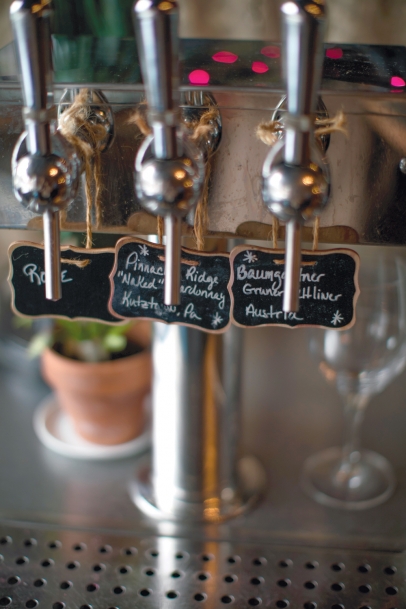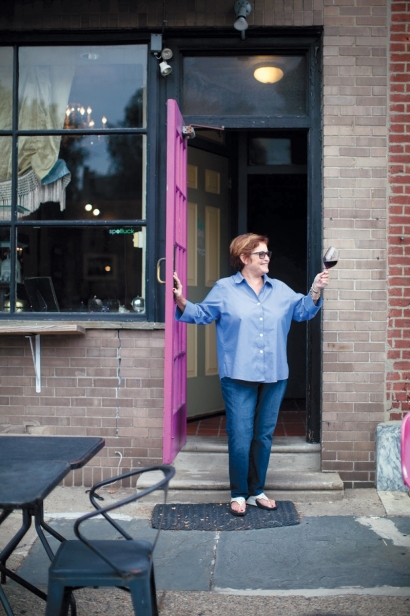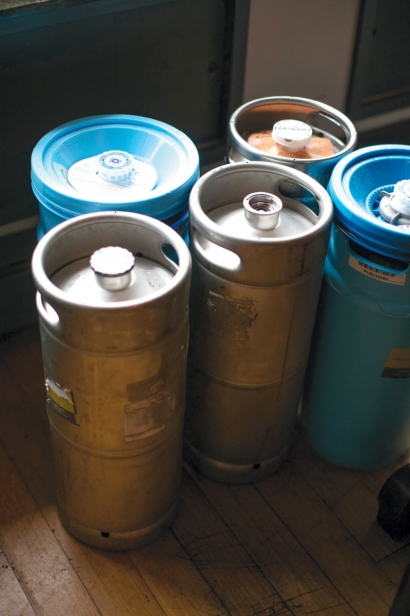To Keg or Not to Keg: That is the Question
As wine taps proliferate throughout the city, local wine producers are divided on how to respond
For most of the modern wine-drinking era, public perception has worked against both kegged and Delaware Valley wines, and with valid reason. The local stuff used to be, for the most part, sickly-sweet concoctions made from some horrible American grape or, worse yet, a different fruit altogether. Kegged wine, where it existed at all, was a bulk-produced, characterless juice that might as well come from a box labeled Franzia. Today, on both fronts, this is all changing.
An expanding number of consumers are seeking out both local wines and wines on tap, with increasing enthusiasm and knowledge. But bringing these two trends together—in the form of locally made wines that you can find on tap—is far more complicated.
To understand why, you need to look back to 2012, when Terry Berch McNally, who owns Fairmount’s neighborhood mainstay London Grill, sought a concept for her Paris Wine Bar that would set the place apart. “Everyone was all about the farmers’ market: local this, local that,” says McNally. “Yet they wanted wine that comes from France, Italy, South Africa. It was such a disconnect, so I thought I’d try to incorporate local wines.”
Around the same time, kegged wine first began appearing on the scene. Because kegs replace the outgoing wine with inert gas instead of air, the wine stays fresh. That reduces waste—and saves money—compared to wine dispensed from bottles. “I’ve been going after wine my whole restaurant life, trying to make it accessible. For many reasons, it’s a harder sell than craft beer, especially around here. But the draft concept allows us to offer an always-changing, innovative by-the-glass program that encourages customers to try something new,” says McNally.
Kegs also offer a number of environmental advantages.They eliminate an immense amount of packaging, including bottles, corks, labels and boxes. The stainless steel variety can last for decades. In addition, kegs weigh less than glass, which cuts down on carbon emissions during shipping.
Due to our liquor laws here in Pennsylvania, bringing this novel approach to Philly was a challenge. For one example, when McNally first started looking into the idea, the largest vessel the Pennsylvania Liquor Control Board sold was five liters. But she found a loophole with in-state vintners, who are not required to work through the PLCB. “I started knocking on doors, literally, of a few local wineries that I knew had premium wines,” she notes. “Most of them slammed it in my face.”
One of the doors that stayed open was Pinnacle Ridge in Pittsville. “We started a keg program because of Terry,” winemaker Brad Knapp recounts. “She invested in stainless kegs and did a bunch of the upfront work, which made it viable for us to get involved. There was no risk of getting stuck with leftover product.” At the time, one of the winery’s priorities was to expand its presence in the Philadelphia restaurant scene, and kegs offered a key benefit. “We thought it would be a competitive edge, since fewer wineries produce this format,” adds Knapp.
Expanded Competition
Four years later, bars and restaurants all over the city are installing keg lines for wine— yet only a few feature local wines. This is, at least partially, a result of McNally’s 2013 effort—with help from Standard Tap’s William Reed, Vetri’s Jeff Benjamin, and state representative Michael O’Brien—to allow drafts from national and international producers. But that’s not the only reason restaurant wine menus aren’t stacked with local wines on tap.
At Paris Wine Bar, they’re still pouring two or three local wines at any given time, alongside a few others from around the country and the world. McNally has trouble keeping the local lines flowing, even as consumer opinion toward both kegged wine and local wine continues to improve. “I’ve been asking this one winery [to sell its wine in kegs] for years. Some people just can’t wrap their brains around it. Even the wineries I have took a long time to get on board.”
“We had a lot of outside people waiting,” she continues. “NYC’s Gotham Project, folks from the Finger Lakes and Long Island, yet the locals still aren’t interested. Even when I say ‘I’ll bring you the keg, you fill it, I pick it up,’ it’s still a hard sell,” says McNally.
Marketing versus Moving
It seems logical that wineries, especially those deep in the countryside, would be lining up for the chance to reach more customers. “Our goal is to get the product in front of as many people as possible,” says Sean Comninos, winemaker at South Jersey’s Heritage Vineyards, another local kegger. “As we grow, it’s important to offer a format that’s drawing increased interest and that showcases our wines in a different setting.”
“You’d think selling these wines in Philly would be a great marketing opportunity,” McNally adds. “Our customers are always interested in brochures from the wineries. We hand them out like crazy. If they go up, spend the day up there, have a great day, that’s a huge connection. They’re a customer for life.”
Galen Troxell of Galen Glen, which produces one of Paris Wine Bar’s first local wines on draft, anticipated this influx of Philadelphians. “I was kegging our best wines, even taking a hit on the pricing, because I thought it was like paying for marketing,” he says. After all, if customers enjoy a glass of wine at a restaurant, it stands to reason that they would want to buy more, perhaps even visit the vineyard. The reality, unfortunately, has been disappointing. “I don’t feel like it ever paid off, at least in that way,” Troxell notes. “I’ve had to shift mentally to think of it more as a way to move product than to build exposure.”
The concept of marketing versus increased sales comes up often. Fort Washington’s Karamoor Estate, a rising local star and critical darling, primarily kegs its entry-level wines (those at lower price points), saving the premium stuff for bottling runs.
“We were looking into a two-tier product system without having a separate name,” says Karamoor’s Ali Duloc, referring to the way some wineries often create a second label, featuring simpler wines made with minimal barrel influence or grapes from young vines. “Instead of doing that, we started our keg program. The base wine is significantly less expensive, which is attractive to restaurants.” Duloc makes it clear this isn’t bad wine, adding that it is “100% grown here, made here, tested and tasted here.”
She’s not wrong. Sipping Karamoor’s red blend at Paris, I find it both approachable and intriguing. Made from mostly Merlot, it’s lush and soft, featuring surprisingly rich fruit with tobacco-tinged nuances. It’s no wonder the majority of Karamoor’s social-media audience consists of people who first tried the wines at restaurants.
Kegging these attractively priced wines also opens the market to bars and breweries that don’t have a strong wine program but want to offer a reasonably priced by-the-glass option. “These guys are weary of bringing on relatively unknown local wines at a relatively high cost and wasting three or four glasses per bottle,” says Comninos. “Kegged wine eliminates the spoilage concerns.”
As the market expands, however, more wineries from the west coast and Europe are offering bargain-basement deals to move their own kegged wines. In a competitive restaurant landscape built on razorthin margins, local wineries are likely to struggle to compete on price and be forced to rely only on the current trend of highlighting local products. In addition, when smaller bars offer drafts as unlabeled house wines, it does little for the winery in terms of marketing.
Knapp, who kegs the same Pinnacle Ridge wines that he bottles, notes a far greater benefit when establishments get behind wineries. “If a restaurant is fully bought in and the staff is properly trained on how to describe and present it, that wine will move. A local stigma still exists to some extent, but it’s pretty easy to get past that with the appropriate training.”
Don’t Believe the Hype
The industry line when it comes to kegs is that they’re superior to bottles because of the way the unused wine is preserved by the inert gas (typically nitrogen or argon). Not everyone, however, sees it that way. Troxell points out that—regardless of whether they are considered house wines—most wine sent to keg programs is meant to be straightforward wine for everyday drinking. “These are solid commercial wines,” he notes, “but they are typically not premium wines.”
Galen Glen specializes in aromatic whites, or varieties that place heavy emphasis on their smell to contribute flavor and character. “There are two ways to store a bunch of wine,” Troxell says. “Fill a container, or fill a container partly and fill the rest with inert gas. Nobody’s going to say that the gas is the better solution. It prevents it from going bad, but if there are a couple of glasses of wine left in a keg and 26 bottles’ worth of empty space, there’s no way the aromatics are going to be the same.”
Sampling an unoaked Chardonnay from Pinnacle Ridge—the lone local white on draft during my visit to Paris Wine Bar—I find the nose, scented with stone fruit and herb, to be satisfactory. Then again, Chardonnay is not considered to be a particularly aromatic grape, and there’s no way to know how full the container is.
“The keg, of course, is still better than many by-the-glass programs,” adds Troxell, “where bottles are sitting half-full of air, oxidizing.”
Barrel to Keg
As complicated and expensive as winemaking can be, the kegging process itself requires surprisingly little in the way of equipment. McNally recalls visiting a Pennsylvania winery that’s since closed its doors. “I was telling the owner how [other wineries] were giving us a hard time about filling kegs,” she tells me. “‘What do you mean they can’t fill kegs?’ the owner demanded. ‘Bring me one right now!’ He then proceeded to grab a hose, stick it in a barrel of his wine and create a siphon with his mouth to fill the keg.” (Perhaps we now know why this winery didn’t last.)
Just because it is easy to fill kegs, however, doesn’t mean it’s easy to run a keg program. Troxell compares the cost of kegging to that of bottling the same amount: 26 standard bottles, including glass, caps and labels, cost around $18. “To keg, I need to get my vessel back from wherever I sent it, then clean and fill it for less than $18. In my operation, that’s very difficult.”
Gino Razzi of Penns Woods, a winery that considered kegging in the past but ultimately decided against it, brings up the ability to fulfill restaurants’ needs consistently. “I only bottle each wine we make once a year,” he says. “In order for a winery to keg, they must have a continuous bottling procedure, once every month or two. We’re just not big enough for that.”
The most cumbersome aspect of stainless-steel kegs is cleaning. “For reusable kegs,” Razzi notes, “the amount of work required to sterilize, stabilize and get it to the right condition for the best wines just isn’t feasible for many small operations such as ours.” Disposable kegs—which operate similarly to the bag-in-box model—tend to appeal more to wineries, but replacing them each time limits the environmental benefits. “They’re also bulky, and I have a hard time fitting them in my system,” adds McNally.
Longer-Term Vision
Though there is clearly a wide range of beliefs regarding the feasibility and benefits of kegging programs, it’s abundantly clear that continued promotion of local wines as viable consumer choices, especially in the restaurant arena, is paramount. In kegs or in bottles, fine wine is increasingly produced here in Pennsylvania, and now is a great time to start drinking it regularly.
“The Pennsylvania industry is finally waking up to real wine,” says Razzi. “Consumers, wine drinkers, are now driving the conversation. They know what good wine is. But if you pursue this, you’re no longer considered a Pennsylvania winery. You’re just a winery, period, that has to stand on its own quality.”
“It doesn’t seem that there are as many local wineries prioritizing restaurant sales,” says Duloc. “It’s not easy, because it takes a certain level of service that many small wineries have trouble meeting. But relying on the tasting room doesn’t get your wine on the same stage as wines from California and France, no matter how many people visit. Having more Pennsylvania wineries on this level would undoubtedly help the entire industry.”
“That’s why I’m here,” concludes McNally. Wineries, she says, “have this great opportunity to serve their wines in Philly, so why aren’t they? Let’s fill these things and get them on the table.”
TOP TAPS
A selection of Philly-area spots pouring locally made wines:
LONDON GRILL/PARIS WINE BAR
2301 Fairmount Ave.
McNally still leads the way, with two or three solid local pours at any given time.
MARTHA
2113 E. York St.
This Kensington watering hole features perhaps the area’s finest local draft-wine list.
EARTH BREAD AND BREWERY
7136 Germantown Ave.
Though it’s hard to pass up Tom Baker’s award winning craft brews, this Mount Airy hotspot pours Karamoor red and white for the vinous set.
TRIA TAPROOM
2005 Walnut St.
The rotating draft list currently features a proprietary Petit Verdot blend from Karamoor.








